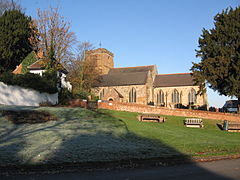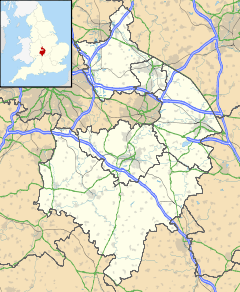- Mancetter
-
Coordinates: 52°34′08″N 1°31′44″W / 52.569°N 1.529°W
Mancetter 
St. Peter's parish church
 Mancetter shown within Warwickshire
Mancetter shown within WarwickshirePopulation 2,449 (2001 census)[1] OS grid reference SP3296 Parish Mancetter District North Warwickshire Shire county Warwickshire Region West Midlands Country England Sovereign state United Kingdom Post town Atherstone Postcode district CV9 Dialling code 01827 Police Warwickshire Fire Warwickshire Ambulance West Midlands EU Parliament West Midlands UK Parliament North Warwickshire Website Welcome to Mancetter Parish List of places: UK • England • Warwickshire Mancetter is a village and civil parish on the outskirts of Atherstone in North Warwickshire, at the crossing of Watling Street over the River Anker.
Contents
History
During the Roman occupation of Britain a posting station was built athwart Watling Street close to the river crossing, and a rectangular earthwork of this station is still extant.[2] Around the station grew the settlement of Manduessedum.[2] It is thought that Mancetter is the most likely location of the Battle of Watling Street, between an alliance of indigenous British peoples led by Boudica and a Roman army led by Gaius Suetonius Paulinus, although the exact location is unknown.
Mancetter does not appear in the Domesday Book of 1086 but in 1196 a Walter de Mancetter granted land to endow the parish church.[2] The chancel walls of the Church of England parish church of Saint Peter still include 12th century masonry.[2] The chancel and nave were remodelled early in the 13th century and the north aisle was added later in the 13th century.[2] The bell tower, the south aisle and the clerestorey of the nave all seem to have been added in the 15th century.[2] The south porch was added early in the 17th century.[2] Restoration work was carried out in 1876, 1911 and 1930,[2] and the Gothic Revival architect C.C. Rolfe may have undertaken restoration work in 1899.[3] The tower has a peal of five bells, of which the oldest was cast about 1350, another early in the 16th century and the treble, tenor and third bell in the middle of the 17th century.[2]
The advowson of St. Peter's was impropriated by the Cistercian Abbey of Merevale in 1449.[2]
Mancetter Manor House is a timber-framed building dating from about 1330.[2] An intermediate floor was inserted in the great hall in about 1480 and the south wing was added in about 1580.[2] The central chinmeystack was probably inserted in the 17th century and small extensions to the house were made in the 18th and 19th centuries.[2]
References
- ^ "Area: Mancetter CP (Parish): Parish Headcounts". Neighbourhood Statistics. Office for National Statistics. http://neighbourhood.statistics.gov.uk/dissemination/LeadTableView.do?a=7&b=800166&c=Mancetter&d=16&e=15&g=493120&i=1001x1003x1004&o=1&m=0&r=1&s=1271808346915&enc=1&dsFamilyId=779. Retrieved 21 April 2010.
- ^ a b c d e f g h i j k l m Salzman, 1947, pages 116-126
- ^ Saint, 1970
Sources
- Pevsner, Nikolaus; Wedgwood, Alexandra (1966). The Buildings of England: Warwickshire. Harmondsworth: Penguin Books. pp. 346–347. ISBN 0 14 0710.31 0.
- Saint, Andrew (1970). "Three Oxford Architects". Oxonensia (Oxfordshire Architectural and Historical Society) XXXV: 53 ff. http://www.oahs.org.uk/oxo/vol%2035/Saint.doc. Retrieved 3 November 2009.
- Salzman, L.F. (ed.) (1947). Victoria County History: A History of the County of Warwick, Volume 4. pp. 116–126.
External links
- Atherstone-forum Mancetter and Athersone online forums
Categories:- Villages in Warwickshire
- Civil parishes in Warwickshire
Wikimedia Foundation. 2010.

